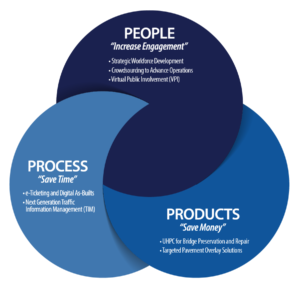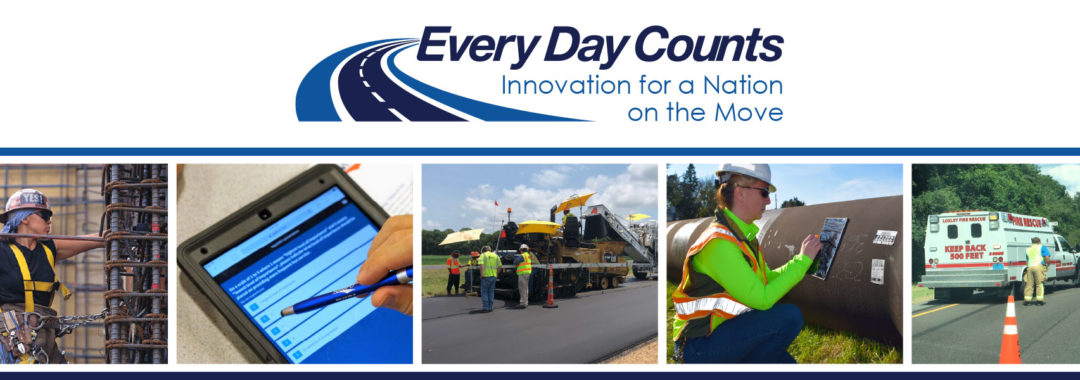 Every two years, FHWA works with state transportation departments, local governments, tribes, private industry and other stakeholders to identify and champion a new collection of innovations that merit accelerated deployment through the Every Day Counts Program (EDC). The FHWA’s Center for Accelerated Innovation (CAI) has recently issued the next round of areas of innovation, EDC-6.
Every two years, FHWA works with state transportation departments, local governments, tribes, private industry and other stakeholders to identify and champion a new collection of innovations that merit accelerated deployment through the Every Day Counts Program (EDC). The FHWA’s Center for Accelerated Innovation (CAI) has recently issued the next round of areas of innovation, EDC-6.
EDC is a state-based model that identifies and rapidly deploys proven, yet underutilized innovations to shorten the project delivery process, enhance roadway safety, reduce traffic congestion, and improve environmental sustainability. Proven innovations promoted through EDC facilitate greater efficiency at the state and local levels, saving time, money and resources that can be used to deliver more projects.
FHWA’s CAI fosters collaboration between stakeholders within the transportation community through the State Transportation Innovation Councils (STIC), which are charged with evaluating innovations and spearheading their deployment in each state.
FHWA announced that it will officially launch EDC-6 by webinar on September 23, 2020. More information is expected to follow regarding virtual summits during which transportation leaders and front-line professionals from across the country will discuss and identify opportunities for implementing the innovations that best fit the needs of their respective state transportation program. Following the summits, New Jersey will finalize their selection of innovations, establish performance goals for the level of implementation and adoption over the upcoming two-year cycle, and begin to implement the innovations with the support and assistance of the technical teams established for each innovation. Further descriptions of each of the EDC-6 Innovations are below:
Crowdsourcing for Advancing Operations. State and local transportation agencies need real-time, high-quality, and wide-ranging information to optimize roadway operations for reduced congestion and increased safety. Agencies are increasing the quality and quantity of operations data with crowdsourcing, which enables staff to make better decisions that lead to safer and more reliable travel and apply proactive strategies cost effectively. With crowdsourced data from multiple streams, agencies can capture in real time what happens between sensors, in rural areas, along arterials, and beyond jurisdictional boundaries.
e-Ticketing and Digital As-Builts. Highway construction projects generate massive amounts of valuable data that historically were communicated via paper, but agencies are improving on paper process by integrating them into electronic and digital workflows. Electronic ticketing improves the tracking, exchange, and archiving of materials tickets. Digital information, such as three-dimensional design models and other metadata, enhances the future usability of as-built plans for operations, maintenance, and asset management. Both can increase project safety, quality, and cost savings through efficient data gathering and sharing.

Strategic Workforce Development is among the innovative initiatives in EDC-6 offering strategies to identify, train, and place workers for highway construction jobs.
Next-Generation Traffic Incident Management: Integrating Technology, Data and Training. More than 6 million traffic crashes are reported each year, creating congestion and putting motorists and responders at risk of secondary crashes. Next-generation traffic incident management (NextGen TIM) builds on FHWA’s national TIM responder training program to shorten the duration and impact of incidents and improve the safety of motorists, crash victims, and responders. NextGen TIM offers tools, data, and training mechanisms that can benefit both new and existing TIM programs, including local agency and off-interstate applications.
Strategic Workforce Development. The demand for highway construction, maintenance, and operations workers is growing while the transportation industry is experiencing a revolution of emerging technologies that require new skills. The Highway Construction Workforce Partnership developed strategies and resources to demonstrate the value of a career in transportation and fill the jobs that support the Nation’s highway system. Resources include the “Identify, Train, Place” workforce development playbook and Roads to Your Future outreach campaign to attract and retain workers in highway construction jobs.
Targeted Overlay Pavement Solutions. Pavement overlays represent a significant portion of highway infrastructure dollars. Many pavements in the highway system have reached or are nearing the end of their design life while carrying traffic that exceeds their initial design criteria. Targeted overlay pavement solutions (TOPS) are now available for asphalt and concrete pavements that enable agencies to maximize their investment and help ensure safer, longer-lasting roadways. TOPS will improve performance, lessen traffic impacts, and reduce the cost of pavement ownership.
Ultra-High Performance Concrete for Bridge Preservation and Repair. Ultra-high performance concrete (UHPC)—a fiber-reinforced, cementitious composite material with mechanical and durability properties that far exceed those of conventional concrete—has become popular for field-cast prefabricated bridge elements. Bridge preservation and repair is a new application of UHPC that offers superior strength, enhanced performance, and improved life-cycle cost over traditional methods.
Virtual Public Involvement. Public engagement during transportation project planning and development helps agencies identify issues and concerns early in the process, which can ultimately accelerate project delivery. Virtual public involvement supports agency efforts to engage the public more effectively by supplementing face-to-face information sharing with technology. Techniques such as telephone town halls, online meetings, and social media increase the number and variety of ways to inform the public, receive feedback, and collect and consider stakeholder input.

